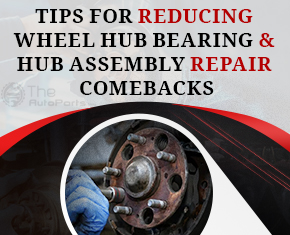Wheel hub assemblies must be able to withstand severe abuse. There are several variables that might cause them to fail, ranging from severe heat to external shocks to road pollutants. Hub assemblies might have a high warranty return rate if they are not constructed robust enough. Be aware of low-cost solutions that will almost certainly wind up in your service bay. Instead, go with a well-engineered, long-lasting item that will not let you or your customers down.
Wheel hub assemblies connect your vehicle’s wheels and rotor to the suspension and are normally joined to the steering knuckle or rear axle flange/spindle. They provide assistance with vehicle load, control, and wheel placement. Above all, they let the wheels rotate as they drive along the road. Depending on the situation. Depending on the weight class of the vehicle, they will feature either ball or tapered rolling components.
Most OEMs have evolved to a fully unitized Generation 3 (Gen 3) design that may be utilised on either driven or non-driven wheels. Third-generation wheel hub assemblies employ small double row ball bearings or tapered rollers that are not dismantled or modified. They are pre-greased and pre-set, and they may include an ABS encoder ring. In contrast to Gen 1 and Gen 2, Gen 3 hub assemblies have two flanges, one of which binds the assembly to the suspension and the other to the brake rotor and wheel.
1. Vibration
As you drive, your suspension components degrade and generate undesirable axial and radial load forces, which eventually become sources of external vibration for the hub assembly. The more the mileage, the greater the risk for vibration, which might impair bearing performance. To avoid this, seek for a hub assembly with anti-vibration features such as a roll-formed construction and thicker flanges. Roll-forming tightens the grip on internal components, reducing vibration and increasing stability, while wider flanges minimise flex and enhance wheel balancing dynamics.
2. Heat
Although hub assemblies are normally built to withstand radiant heat from braking components, frequent exposure to high temperatures can cause deformation inside the internal raceway as well as in the rolling elements within the raceway. This distortion increases friction inside the moving parts, raising temperatures and hastening deformation.
Look for a part that is engineered for optimal hardness and finish of the raceway and rolling elements, using quality steel to ensure all surfaces remain smooth and uninhibited, to help protect the hub assembly from excessive heat. Picking a hub assembly with a high temperature and pressure rated grease will also protect against temperature spikes caused by extended braking.
3. Seals
Failure of a seal can destroy a hub assembly faster than anything else. If the seals fail, water and contaminants will enter the assembly’s internals & likely wash the grease out. Contaminants such as dirt and grime could permeate the remaining grease, making it abrasive and eventually destroying the raceway and rolling elements. To avoid this problem, look for a hub assembly that has upgraded seals, such as a multi-seal and lip design, to provide the most secure barrier against moisture and contaminants.
The key to enhancing the performance and durability of any hub bearing is preventative maintenance. For your convenience, below is a list of maintenance tips:
1. Inspect and clean the mounting point surface while changing your Wheel Bearing & Hub Assembly to ensure a level installation.
2. Examine lug nuts for corrosion and inner thread peeling.
3. Ensure that the ABS cable is secure and free of moving components.
4. Replace suspension parts as needed to avoid premature bearing wear and strain.
5. Rotate your tyres every other oil change to ensure even tyre wear and a smooth ride.
6. Tighten the bolt to the torque specification specified by the OEM manufacturer for your car.
7. After each tyre rotation, inspect your wheel lugs for adequate torque.
8. At least once a year, check for correct wheel alignment.
9. Stay away from Potholes.
